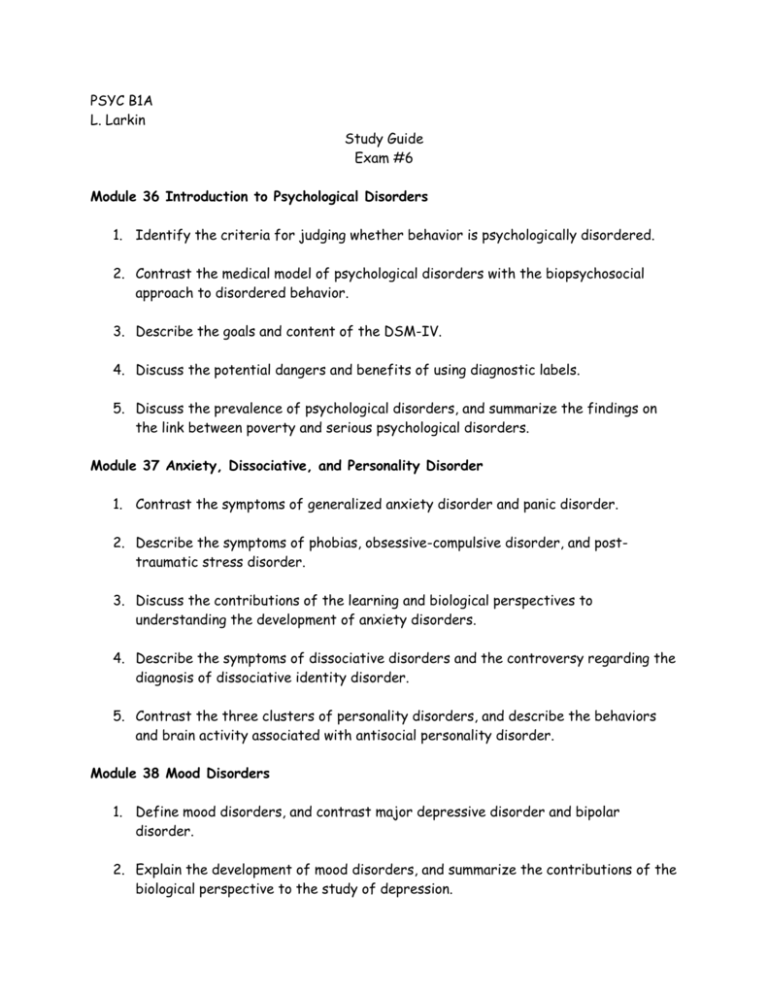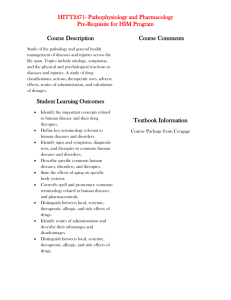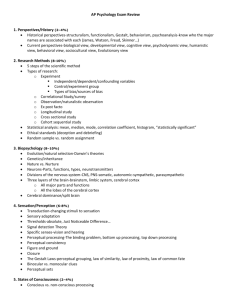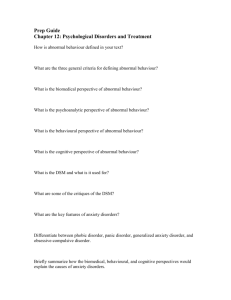PSYC B1A - Bakersfield College
advertisement

PSYC B1A L. Larkin Study Guide Exam #6 Module 36 Introduction to Psychological Disorders 1. Identify the criteria for judging whether behavior is psychologically disordered. 2. Contrast the medical model of psychological disorders with the biopsychosocial approach to disordered behavior. 3. Describe the goals and content of the DSM-IV. 4. Discuss the potential dangers and benefits of using diagnostic labels. 5. Discuss the prevalence of psychological disorders, and summarize the findings on the link between poverty and serious psychological disorders. Module 37 Anxiety, Dissociative, and Personality Disorder 1. Contrast the symptoms of generalized anxiety disorder and panic disorder. 2. Describe the symptoms of phobias, obsessive-compulsive disorder, and posttraumatic stress disorder. 3. Discuss the contributions of the learning and biological perspectives to understanding the development of anxiety disorders. 4. Describe the symptoms of dissociative disorders and the controversy regarding the diagnosis of dissociative identity disorder. 5. Contrast the three clusters of personality disorders, and describe the behaviors and brain activity associated with antisocial personality disorder. Module 38 Mood Disorders 1. Define mood disorders, and contrast major depressive disorder and bipolar disorder. 2. Explain the development of mood disorders, and summarize the contributions of the biological perspective to the study of depression. 3. Summarize the contributions of the social-cognitive perspective to the study of depression. Module 39 Schizophrenia 1. Describe the symptoms of schizophrenia. 2. Contrast chronic and acute schizophrenia. 3. Outline more abnormal brain chemistry, functions, and structures associated with schizophrenia, and discuss the possible link between prenatal viral infections and schizophrenia. 4. Discuss the evidence for a genetic contribution to the development of schizophrenia. Module 40 The Psychological Therapies 1. Define psychotherapy, and explain what we mean by an eclectic approach to therapy. 2. Define psychoanalysis, and discuss the aims, methods, and criticisms of this form of therapy. 3. Contrast psychodynamic therapy and interpersonal therapy with traditional psychoanalysis. 4. Identify the basic characteristics of the humanistic therapies, and describe the specific goals and techniques of Carl Rogers’ client-centered therapy. 5. Explain how the basic assumption of behavior therapy differs from those of traditional psychoanalytic and humanistic therapies, and describe the techniques used in exposure therapies and aversive conditioning. 6. State the main premise of therapy based on operant conditioning principles, and describe the views of proponents and critics of behavior modification. 7. Contrast cognitive therapy and cognitive-behavior therapy, and give some examples of cognitive therapy for depression. 8. Discuss the rationale and benefits of group therapy, including family therapy. Module 41 Evaluating Psychotherapies 1. Explain why clients and clinicians tend to overestimate the effectiveness of psychotherapy. 2. Discuss some of the findings of outcome studies in judging the effectiveness of the psychotherapies. 3. Describe which psychotherapies are most effective for specific disorders. 4. Evaluate the effectiveness of eye movement desensitization and reprocessing (EMDR) and light exposure therapies. 5. Describe the three benefits attributed to all psychotherapies. 6. Discuss the role of values and cultural differences in the therapeutic process. 7. Explain the rational of preventive mental health programs. Module 42 The Biomedical Therapies 1. Identify the biomedical therapies, and explain how double-blind studies help researchers evaluate a drug’s effectiveness. 2. Describe the characteristics of antipsychotic, anti-anxiety, antidepressant, and mood-stabilizing drugs, and discuss their use in treating psychological disorders. 3. Describe the use of brain stimulation techniques in treating specific disorders, and discuss some possible alternatives to ECT. 4. Summarize the history of the use of the psychosurgical procedure known as the lobotomy, and discuss the use of psychosurgery today. Module 43 Social Thinking 1. Contrast dispositional and situational attributions, and explain how the fundamental attribution error can affect our analysis of behavior. 2. Define attitude, and explain how attitudes and actions affect each other, especially in certain social situations and in particular social positions. 3. What is cognitive dissonance and when are we most likely to experience cognitive dissonance? Module 44 Social Influence 1. Discuss Asch’s experiments on conformity, and list some of the conditions that strengthen conformity. 2. Describe Milgram’s experiments on obedience, and explain how the conformity and obedience studies can help us understand our susceptibility to social influences. 3. Describe conditions in which the presence of others is likely to result in social facilitation, social loafing, or deindividuation. 4. Discuss how group interaction can facilitate group polarization and groupthink, and identify the characteristic common to minority positions that successfully sway majorities. Module 45 Social Relations 1. Identify the three components and various forms of prejudice. 2. Discuss the social factors that contribute to prejudice. 3. Cite four ways that cognitive processes help create and maintain prejudice. 4. Explain how psychology’s definition of aggression differs from everyday usage, and describe various biological influences on aggression. 5. Outline psychological triggers of aggression, noting the relationship between violent video games and aggressive behavior. 6. Describe the influences of proximity, physical attractiveness, and similarity on interpersonal attraction. 7. Describe the effect of physical arousal on passionate love, and identify two predictors of enduring companionate love. 8. Define altruism, and describe the steps in the decision-making process involved in bystander intervention.











